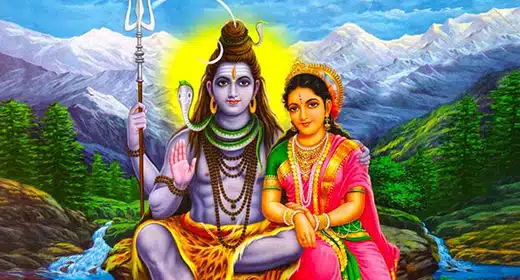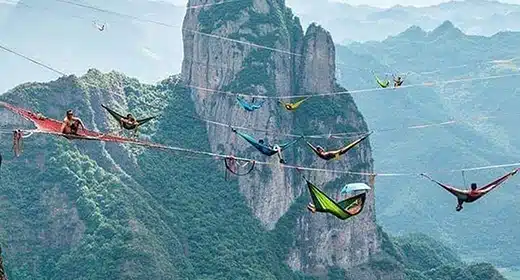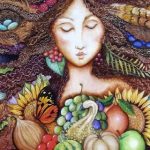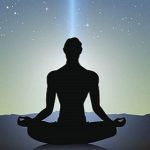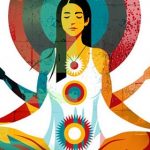by Swami Karma Karuna: The term ‘Vedanta’, or ancient texts such as the Upanishads, may ring a bell, but for many, they are shrouded in mystery…
…scholastic views or firmly wedged in history.
Perhaps one wonders how these ancient philosophies relevant to the modern-day yogi, engaged in holding a Warrior II Pose?
According to Vedanta, anything that is changeable or measurable, or which has a beginning and end, is Maya. It often translates as illusion or magic, seemingly real, but veiling the truth. Situations, careers, relationships, human life all have beginnings and endings and are thus considered part of this changeable Maya.
Think about your journey from childhood to adulthood and how perceptions of what is real or true may have altered through life experience – for example, the belief in Santa Claus or the concept of love. These changing ideas are considered by Vedanta to be the trap of illusion, in which reality is not as it seems, thus limiting the ability to experience the highest reality.
The word Vedanta is two-fold – ‘veda’ meaning ‘the complete process of knowledge’ and ‘anta’ which signifies ‘culmination’. Therefore, Vedanta translates as a ‘’culmination of a process of knowledge’ or the ‘highest knowledge’.
The aim of Vedanta is to experience the ultimate knowledge, described as Brahman. Brahman comes from the root ‘Brihm’ meaning to pervade all space. It translates as an ever-expanding state of consciousness, often expressed as the transcendental experience of ‘oneness’.
In day-to-day life, oneness is frequently elusive. We react to a significant other; get caught in the monkey mind or the pains and pleasures of the body. This generates separation, creates attachments and misunderstandings, and ultimately contracts the experience of life. This feeling of separation may be with another person, within the self, or perhaps our own version of a ‘Higher Source’. According to Vedanta, we are caught in the veil of the temporary changing world unable to see the truth of who we are.
Expanding Consciousness through Yoga
Vedanta, like modern psychology, describes different states of consciousness; the conscious waking state of the senses interacting with daily life, the subconscious dreaming state where day to day experiences are stored, and the unconscious deep sleep state where name, form and idea vanish. Vedanta goes one step further, adding that as humans, we have the potential to reach the super-conscious state or the highest experience.
In normal life, we mainly understand and interact with the world through the senses of smell, taste, sight, touch, sound and the stored impressions based on culture, education and past experience. These give us a pair of veiled glasses that we relate to the world through. Deep-seated beliefs and memories get collected in the sub-conscious and unconscious layers and can be responsible for unhealthy mental or physical states and limiting views of the world. Although, the unconscious layer contains enormous potential and is said to be the source of ‘knowing’, we are usually asleep to this potential both in the waking state of daily life and during the eight hours we sleep each night.
Aims in yoga practice include expanding self-understanding and increasing health at all levels. In this process of knowing ourselves more deeply and optimising our health, there is the potential to free impressions and patterns that limit us. The aim of Vedanta is to go beyond the limited and trapped experience of the ‘I’ or ‘ego’ self, which is identified with the senses, mind and thoughts, and to instead connect to the universal transcendental state of the super-conscious.
We think we are the thought or we are the body, but as Swami Sivananda sings,
“I am not this body, I am not this mind, I am not these senses, Immortal Self am I”.
How Can an Ancient Philosophy be Useful on the Yoga Mat of Today’s Fast-Paced World?
Whilst this ultimate experience may seem far-fetched in the rush of the world, a regular sadhana or practice for transformation such as a set of postures, breathing techniques or a daily meditation can help us to unfold new layers of understanding. We can learn to go beyond the limitations of the body and mind. During practices like Yoga Nidra Deep Relaxation, the body sleeps but the mind aims for awareness, allowing conscious access to the normally shrouded subconscious and unconscious layers that create the illusion. With consistent practice, there is a gradual weeding out of the limiting aspects and a flowering of positivity, hidden in these deeper stratums. This leads to the gradual expansion of consciousness, one of the main aims of Vedanta. If you feel called to experience the life-changing benefits of this practice, learn more about it, and take control of your mental, physical and emotional well being, join us at Anahata Yoga Retreat for a Yoga Nidra & Restorative Yoga Immersion. To go even deeper with the practice and learn to teach it, you can stay for the Yoga Nidra & Restorative Yoga Teacher Training course, which includes a 3-month training package. Find out more at www.anahata-retreat.org.nz
Where did Vedanta come from?
The philosophy of Vedanta was born from The Vedas, which have been cited as the oldest source of written knowledge containing the wisdom of all ages. Some call them religious teachings, others say they are philosophies of life and they are deemed to be part of the Sanatan Dharma or ‘eternal way of living’, which forms the basis for Hinduism as a culture.
Scholars do not agree upon the origins of yoga, however, yoga postures, methods for self-enquiry, austerities, mantras and common yogic attitudes are also cited in the Vedas.
In Yoga Darshan – Vision of the Yoga Upanishads, Swami Niranjanananda expresses the Vedas as a
“Collection of original, spiritual, practical, moral, social and metaphysical thoughts of seers, who perceived every aspect of creation as a form, as a manifestation of divine nature.”
The Vedas are revered as revealed knowledge, called ‘sruti’, which means ‘heard’. Divine or revealed knowledge is said to be experienced in deep states of meditation by enlightened Sages called Rishis. This knowledge has then been passed down through the generations in the form of Sanskrit chants, stories and teachings, which continue to be used today.
The Four Main Vedas
In the four Vedas
“You can find every topic, whether it is spirituality, philosophy, politics or sociology…. They do not merely discuss politics and empires, they tell about geography and history as well as the absolute form of creation”.
Swami Satyananda Saraswati, The Vedas
The four Vedas reveal ‘knowledge’ in different areas:
Rig Veda, ‘Knowledge of the Hymns of Praise’, is the largest and most significant text of the Vedic collection and is said to contain the knowledge of all the others. Rig means ritual and many of the prayers (mantras) are in worship of the divinity of nature.
Yajur Veda, ‘Knowledge of the sacrificial formulas’, is the performance of rituals. Yajur means ceremony and explains the rituals, offerings and sacrifices for everything humans do in the path of life.
Sama Veda, ‘Knowledge of the Melodies’, means singing. These sung texts come mainly from the Rig Veda, however, they are arranged differently and include strict rules on how to chant them. The roots of Indian classical music and dance come from the Sama Veda.
Atharva Veda, ‘Knowledge of the Magic formulas’, comprises the sciences including yoga, medicine, herbology and contains formulas, spells, charms and magical incantations. Ayurveda (knowledge of life to maintain health) is a subdivision of this Veda.
This huge body of knowledge was further classified within each of the four Vedas. Each compilation of mantras and prayers deals with different stages of life. The first two categories are related to daily life experiences like marriage, birth, death, beginning a business and also ethics and duties within family and society. The additional teachings provide the deeper meaning and interpretation of the sacred ceremonies and were intended for those who had withdrawn from society to the forest for spiritual life.
The final category, known as the ‘Upanishads’, are the concluding portions in each of the Vedas, the culmination of the knowledge, and are, in themselves, referred to as Vedanta. They focus on higher philosophical questions and teachings about the nature of oneness or Brahman. These were revealed to ascetics and those dedicated fully to spiritual life. One of the definitions of Vedanta is “the end of the Vedas” and includes the Upanishads, the Bhagavad Gita and other great epics of India, the Puranas, Sanskrit hymns, and additional works of literatures.
And How are the Vedas Relevant Today?
Although these teachings date back possibly 45,000 years, they are still pertinent to the modern human. They propound that the purpose of human life is to attain higher consciousness. Desires, passions and ambitions will exist as long as the human body endures, and they need to be expressed at certain stages of life. However, this same human body and mind can also be used to expand the consciousness. The Vedas give a pathway of evolution in order to connect to Brahman or universal consciousness – also the ultimate aim of yoga practice, to yoke or experience ‘union’.
As Georg Feuerstein says in The Deeper Dimensions of Yoga,
“Liberation is a matter of recovering the Self in the midst of the hustle and bustle of life and then transforming life in the light of that realisation. This is the ideal celebrated in the non-dualistic tradition of Vedanta”.
Vedanta Practices for Everyday Life
So how can we bring Vedanta practices into our daily lives to effect change at a deeper level? What habits, rituals and practices can we integrate to make the most of these gifts?
1. Developing Mindfulness – In yogic terms this is called the witness or the unaffected observer. Mindfulness-based practices, such as Inner Silence Meditation (Antar Mouna) help to develop the observer in front of the movements of the mind and senses. With formal practice, the capacity to apply this concept to daily life grows. When there is an ability to step back from the emotional, sensorial and mental experiences, defined as Maya, one begins to realise that much of what goes on internally is projections, memories and patterned responses. The ability to observe gives the practitioner a choice as to how, when, why and what the response to any given situation or challenge may be. In this way, it is easier to see the illusions for what they are and have more capacity to choose how we interact with our day-to-day experiences.
2. Viveka- This translates as discrimination or right knowledge – a quality of the higher mind. In the experience of Maya, we identify with the internal experiences of life such as the mind and emotions, or external associations such as job title, roles or possessions, and we lose perspective. With the consistent practice of ‘witnessing awareness’, paired with discrimination, we can begin to see the desires – the pull of the basic instinctual drives that don’t serve us such as jealousy, ego, anger, insecurity or grasping for sustenance outside of the Self. Viveka is a product of transformation, which allows us to know the difference between right and wrong, real and unreal. With regular practice of yoga, meditation and relaxation techniques, we develop a stronger ability to make ‘right’ choices that support happiness and peace.
3. Vairagya – is non-attachment or dispassion. It is an indifference to sensory enjoyments and takes us beyond the pairs of opposites such as pain and pleasure. This concept is often misunderstood to mean giving away possessions or no longer feeling for others. It is not the object that is the problem, but the identification with it, that causes suffering or need.
Think about the banker who has thousands of dollars pass through her hands every day. Because there is no personal relationship with the money, it comes and goes and does not cause her joy or pain. However, if that same banker lost her wallet with $500 in it, personal attachment to the money as her own would cause her pain to lose it.
True vairagya is the ability to be in the marketplace of life with an attitude of balance. When the item, person or experience is available to you, then enjoy it, but keep the same attitude when it is gone.
Vairagya can be practiced with small things to begin with, for example, start to notice those objects, foods, ideas that cause pain when they are gone or that you grasp for to fulfill yourself. Experiment with having it and not having it and observe the feelings, mental states, likes and dislikes. With self-enquiry and the ability to witness the life experience, we can gain more freedom inside of ourselves.
While the roots of Vedanta were seeded in ancient times, the teachings are equally as relevant today.
Yoga classes around the globe often end with the teacher putting their hands in prayer position and saying, “Namaste, The Divine in me honours the Divine in you”. When we place our palms together and say Namaste, we are acknowledging an essential Vedic truth; beyond the illusions, we are all One.






